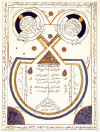Ophthalmological instruments of Al-Halabi fill in a gap in the biomedical engineering history
- PMID: 35117978
- PMCID: PMC8790312
- DOI: 10.5662/wjm.v12.i1.1
Ophthalmological instruments of Al-Halabi fill in a gap in the biomedical engineering history
Abstract
Al-Halabi is an intriguing ophthalmologist who invented numerous surgical instruments for treating various eye diseases. The illustrations of such instruments in his invaluable book "Kitab Al-Kafi fi Al-Kuhl" reflect his willingness to teach. Moreover, he included in his book a magnificent illustration of the anatomical structure of the eye. The book reflects Al-Halabi's medical practice and teaching and shows several advanced medical techniques and tools. His invaluable comments reflect his deep experimental observations in the field of ophthalmology. The current article provides proof that Al-Halabi is one of our early biomedical engineers from more than 800 years ago. Al-Halabi represents a ring in the chain of biomedical engineering history. His surgical instruments represent the biomechanics field. Al-Halabi should be acknowledged among the biomedical engineering students for his various contributions in the field of surgical instruments.
Keywords: Al-Halabi; Biomedical engineering education; Biomedical engineering history; Ophthalmological instruments.
©The Author(s) 2022. Published by Baishideng Publishing Group Inc. All rights reserved.
Conflict of interest statement
Conflict-of-interest statement: There is no conflict of interest associated with the single author contributed his efforts in this manuscript.
Figures



















References
-
- Gooday G, Lynch JM, Wilson KG, Barsky CK. Does science education need the history of science? Isis. 2008;99:322–330. - PubMed
-
- Valentinuzzi ME. Why study the history of BME, science, and technology? IEEE Pulse. 2011;2:45–47. - PubMed
-
- Taylor HR. Trachoma is an ancient disease and a weapon of mass destruction. In: Taylor HR. Trachoma: A blinding scourge from the bronze age to the twenty-first century. Victoria, Australia: Centre for Eye Research Australia, 2008: 1-16.
-
- Griffith FLI. The inscriptions. In: Petrie WMF, Griffith FLI. The royal tombs of the first dynasty. London, UK: Cambridge University Press, 1900-1901: 48-55.
Publication types
LinkOut - more resources
Full Text Sources
Miscellaneous

